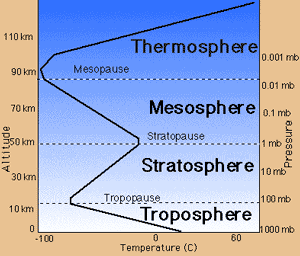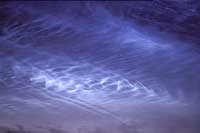THE NATURAL ENVIRONMENT
Geography 101
ToC
SKY
Origin
Air
Layers
Sunlight
Scatter
Refract
Hawai'i
Layers
Atmosphere is a general term for all gas molecules attached to the Earth by gravity. Within the atmosphere, climatologists distinguish several layers based on both temperature variations and function.
 The
most widely recognized atmospheric layers are based on temperature
change with height. The lowest layer, containing 90% of the entire air
mass and the home of virtually all weather phenomena, is the troposphere.
In this layer, air temperature decreases with height at an average
of
about 6.5° C per kilometer (3.6° F per 1000 feet). If you have ever driven or walked up a high mountain, you know that it becomes cooler as you move higher. This
temperature decrease, combined with surface heating, causes
the troposphere to continuously churn and mix, producing
clouds and
weather.
The
most widely recognized atmospheric layers are based on temperature
change with height. The lowest layer, containing 90% of the entire air
mass and the home of virtually all weather phenomena, is the troposphere.
In this layer, air temperature decreases with height at an average
of
about 6.5° C per kilometer (3.6° F per 1000 feet). If you have ever driven or walked up a high mountain, you know that it becomes cooler as you move higher. This
temperature decrease, combined with surface heating, causes
the troposphere to continuously churn and mix, producing
clouds and
weather.
The transitional zone between the troposphere and next highest layer is called the tropopause. The tallest clouds, those found in hurricanes and thunderstorms, can rise to the tropopause but no higher. This can be as high as 16 kilometers (10 miles), but varies with latitude and season. In general, the height of the tropopause decreases with increasing latitude from a full 16 km (10 mi) over the equator to about 10 km (6 mi) over the poles.
|
|
BOX 1 |
Above the tropopause, the temperature increases with height, as shown in the diagram, defining the stratosphere. This is a very important layer to living things as it contains atmospheric ozone. Ozone strongly absorbs ultraviolet (UV) light, which, in high intensities, can be fatal to living organisms. Absorption of UV light by ozone heats the stratosphere, especially at the highest altitudes, causing it to warm with height. This warming limits the height of the tropopause, which in turn limits the depth of storm clouds and thus limits storm intensity. Unlike the troposphere, the stratosphere is relatively stable and does not "churn and mix," hence stays relatively free of clouds.
 At
the top of the stratosphere lies the stratopause, and beyond
that the
mesosphere, home of rare noctilucent clouds as shown in the photo. Higher still is the mesopause and thin thermosphere, a layer extending into space that is heated by absorption of the shortest solar wavelengths. Although the
temperature of the thermosphere is high, the molecules are so far apart that you would quickly
freeze solid if exposed.
At
the top of the stratosphere lies the stratopause, and beyond
that the
mesosphere, home of rare noctilucent clouds as shown in the photo. Higher still is the mesopause and thin thermosphere, a layer extending into space that is heated by absorption of the shortest solar wavelengths. Although the
temperature of the thermosphere is high, the molecules are so far apart that you would quickly
freeze solid if exposed.
Function also defines atmospheric layers. Perhaps the most important functional layer to living things is the ionosphere, without which life at the surface could not exist. The ionosphere, which includes the thermosphere and top portion of the mesosphere, absorbs the very shortest wavelengths such as cosmic rays, gamma radiation, X-rays, and other short wavelengths emitted by the Sun. The reactions produce charged particles, which give rise to spectacular auroral displays, such as the Northern Lights, also called Aurora Borealis. Wavelength bands in sunlight, including UV, X-rays, and gamma rays, are discussed in the next section.